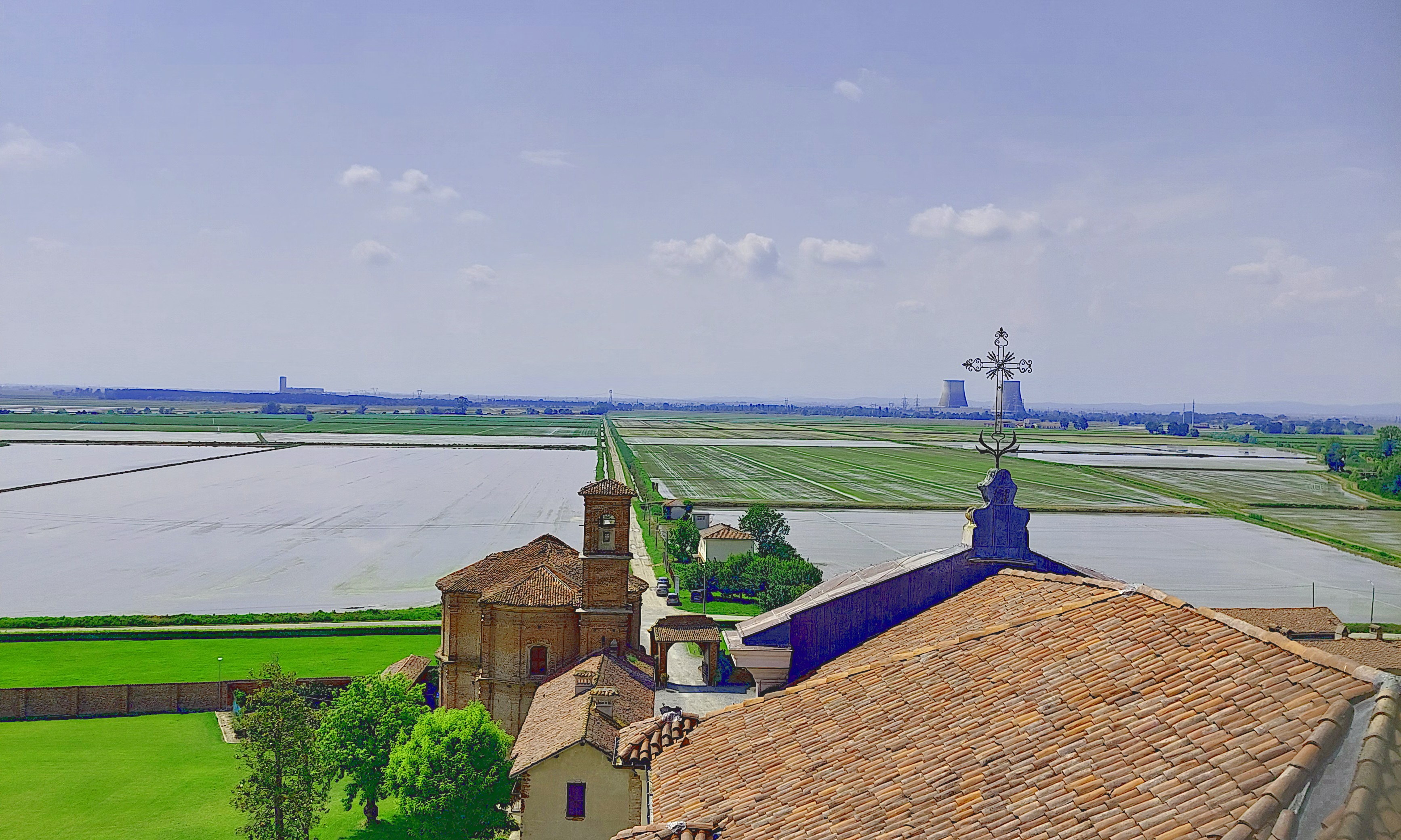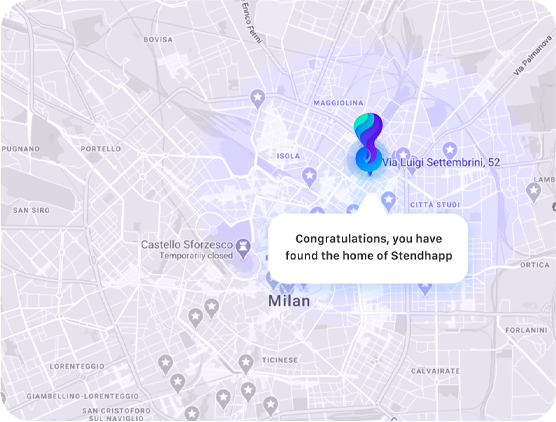In spring the first thing that strikes you is the light, which seems to go from below upward, from the reflection of the sky on the flooded rice fields. They call it a “checkered sea,” but more than a sea it looks like an upside-down world, where waders of all kinds fly around, reminding us of the times when there were only swamps and forests here.
In the countryside around Vercelli the cultivation of rice arrived only around 1400, thanks to a brilliant idea of Cistercian monks originally from Burgundy, who in 1123 had received from Marquis Ranieri I of Monferrato land to be reclaimed near the Via Francigena and had built a fortified abbey there: the Abbey of Santa Maria di Lucedio. The abbey soon became a true economic power, with estates extending from the Canavese and to the Monferrato and a system of “grange” (literally: granaries), farms run by conversi who made them profitable for the abbey’s monks.
Cavour and the World’s Most Powerful Nuclear Power Plant
The octagonal bell tower of Santa Maria di Lucedio stands out against a horizon of rice paddies, almost in symmetry with the two huge chimneys of the now-disused Galileo Ferraris thermoelectric power plant in Leri. It was the first combined-cycle plant in Italy, but its imposing cooling towers are the legacy of quite different projects: in fact, the plant was created as Trino Vercellese‘s second nuclear power plant, to be built alongside the Enrico Fermi power plant, which cannot be seen from afar but is located not far away. At the time of its debut on January 1, 1965, the Trino Vercellese nuclear power plant was the world’s largest enriched uranium plant, and it later achieved the world record for uninterrupted operation at full power: 322 days, from September 28, 1974, to August 16, 1975. In short, in its day a true technological gem was put to sleep following the 1987 referendum. Thinking of the light rising from below, we imagine with a shudder what this territory would have become if it had really generated in its bowels the energy of two power plants of that power.
Such grandeur had distant roots, since in the grange of Leri, ceded by the Borghese family in 1822 to Michele Benso who assigned it to his son Camillo, the young statesman put into practice the future agricultural policies of the Kingdom. And it was at Leri Cavour, now vandalized and inaccessible, that Camillo Benso Conte di Cavour, a passionate and expert in hydraulics, conceived, together with engineer Carlo Noè who followed the project operationally, the Cavour Canal, or the greatest work of hydraulic engineering ever completed in Italy. The artificial canal takes water from the Po River near Chivasso and discharges into the Ticino River at Galliate, after an 83-km journey to support local agriculture. It was built in just 4 years and still does its job honorably, a manifesto of a fledgling Italy that wanted to prove it could accomplish public works well and quickly.
From the Fourth Crusade to Led Zeppelin
Matilde Cassani’s Scarecrows guarding the Principality’s back door wink at the legends and rituals of a magical and at the same time mysterious land.
One has to go back to the early 1200s, when the fate of Lucedio became intertwined with that of Boniface I of Monferrato: Boniface led the ill-fated Fourth Crusade that ended with the sack of Constantinople, the excommunication of all Crusaders and the deposition of Emperor Alexis III, who was sent into exile and imprisoned precisely in Lucedio together with his wife Euphrosyne. Inside the bell tower, built in the 1700s by a student of architect Juvara on an earlier structure, is a sarcophagus that some associate with the Queen of Patmos, fleeing her incestuous father, and others with Euphrosyne herself. According to a different version, Euphrosyne would instead have been buried under the semi-ruined little church of Santa Maria delle Vigne a few hundred meters from the Principality. A fresco depicting a pipe organ and a score can be seen inside the small church: it is said that playing the score backwards, as in the case of Led Zeppelin‘s famous Stairway to Heaven, would even render freedom to the devil, imprisoned since the 17th century in the crypt of Santa Maria di Lucedio and watched in full view by a semicircle of mummified abbots.
These are typical legends of an era well described by Sebastiano Vassalli in his novel La Chimera, but the fact remains that on September 10, 1784, Pope Pius VI officially excommunicated Lucedio and dispersed the monks to end a long period of blasphemy, heresies, sexual perversion and psychological terror of the population. The narrative is entirely consistent with the mystery of the weeping column inside the abbey’s Chapter House, the place where trials were held and sentences issued that often included punishments for the poor people of the surrounding area. One plausible explanation is that the porous material from which the column is constructed absorbs and releases moisture from the ground.
Napoleon and the birth of the Principality
In 1792 the properties of Lucedio passed to the Savoys, but within a few years Napoleon (could he have missed it?) also took over, who gave them to Camillo Borghese as partial compensation for the wonderful art collections he had requisitioned from him in Rome. When Napoleon fell, a dispute arose between the Borghese and Savoy families over the ownership of Lucedio. The properties were divided into lots, and the abbey complex of Lucedio passed to Marquis Giovanni Gozzani of San Giorgio who, in turn, ceded the estate to the Genoese Duke Raffaele de Ferrari di Galliera, on whom the Savoys themselves conferred the right to bear the title of Prince: thus Lucedio finally became the present Principality. It is currently owned by the Cavalli d’Olivola family, who still produce rice and other agricultural products and rent it out for private events and weddings.
Lucedio: Lucifer or Sacred Forest?
Lucedio, whose name for many evokes the “Light of God” or “God of Light,” or the Lucifer of local legends, we like to think that it derives instead from the Latin word “lucus“-the sacred forest. As sacred as the nearby Forest of the Partecipanza, which still stands today on the eternal rules of civil coexistence of the local community.





